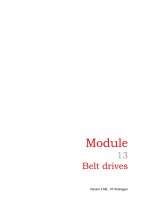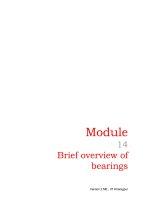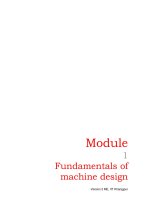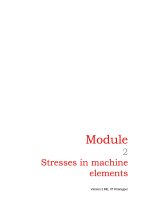Fundamentals of Machine Design P39
Bạn đang xem bản rút gọn của tài liệu. Xem và tải ngay bản đầy đủ của tài liệu tại đây (192.32 KB, 10 trang )
Module
13
Belt drives
Version 2 ME , IIT Kharagpur
Lesson
3
Design of V- Belt drives
Version 2 ME , IIT Kharagpur
Instructional Objectives:
At the end of this lesson, the students should be able to understand:
• Features of V-belt drives
• Nomenclature of V-belt, types of V-belt section and its power rating
• Selection procedure of V-belt
13.3.1 V - Belt Drives
Among flexible machine elements, perhaps V-belt drives have widest industrial
application. These belts have trapezoidal cross section and do not have any
joints. Therefore, these belts are manufactured only for certain standard lengths.
To accommodate these belts the pulleys have V shaped grooves which makes
them relatively costlier. Multiple groove pulleys are available to accommodate
number of belts, when large power transmission is required. V-belt drives are
most recommended for shorter center distances. In comparison to flat belt drives,
these drives are slightly less efficient. V belt can have transmission ratio up to
1:15 and belt slip is very small. As the belts are endless type, V-belt drives do not
suffer from any joint failure and are quiet in operation. V-belts constitute fabric
and cords of cotton, nylon etc. and impregnated with rubber.
13.3.2 Nomenclature of V-belt
A typical V-belt section is
shown in Fig.13.3.1. The
geometrical features of the belt
section are indicated in the
figure. The pitch line, which is
also marked as N-A, is the
neutral axis of the belt section.
The design calculations for V-
belt drives are based on the
pitch line or the neutral axis.
These belts are available in
various sections depending
upon power rating.
N
A
width
inside line
pitch line
thickness
Fig. 13.3.1
wedge angle (θ)
13.3.3 Standard V-belt sections
The standard V-belt sections are A, B, C, D and E. The table below contains
design parameters for all the sections of V-belt. The kW rating given for a
Version 2 ME , IIT Kharagpur
particular section indicates that, belt section selection depends solely on the
power transmission required, irrespective of number of belts. If the required
power transmission falls in the overlapping zone, then one has to justify the
selection from the economic view point also.
Section kW range Minimum pulley pitch
diameter (mm)
Width
(mm)
Thickness
(mm)
A 0.4 - 4 125 13 8
B 1.5 -15 200 17 11
C 10 -70 300 22 14
D 35-150 500 32 19
E 70-260 630 38 23
As for example, a single belt of B section may be sufficient to transmit the power,
instead of two belts of A section. This may increase the cost as well as weight of
the pulley, as two- grooved pulley is required. In general, it is better to choose
that section for which the required power transmission falls in the lower side of
the given range.
Another restriction of choice of belt section arises from the view point of minimum
pulley diameter. If a belt of higher thickness (higher section) is used with a
relatively smaller pulley, then the bending stress on the belt will increase, thereby
shortening the belt life.
13.3.4 Designation of V belt
It has been mentioned that, the calculations for V-belt drives are based on pitch
diameter. However, V-belts are designated with nominal inside length (this is
easily measurable compared to pitch length). Therefore, to arrive at the inside
length, the following relationship is useful.
Inside length + X=Pitch Length
(13.3.1)
Value Of X
A B C D
X (mm) 36 43 56 79
For example, a B- section belt with nominal inside length of 1016 mm or 40
inches (nearest value obtained from belt catalogue) is required for a V-belt drive.
Then this belt is designated as,
(mm) (inches)
B 1016/40
Version 2 ME , IIT Kharagpur
13.3.5 V- belt Equation
V-belts have additional friction grip due to the presence of wedge. Therefore,
modification is needed in the equation for belt tension. The equation is modified
as,
2
/sin
1
2
2
2
Tmv
e
Tmv
θ
μα
−
=
−
(13.3.2)
Where θ is the belt wedge angle
13.3.6 V-belt power rating
Each type of belt section has a power rating. The power rating is given for
different pitch diameter of the pulley and different pulley speeds for an angle of
wrap of 180
ο
. A typical nature of the chart is shown below. Here, for example, for
pitch diameter of D
1
, power rating of the A section belt is kW
1,
kW
2
, kW
3
, kW
4
for belt speeds of N
1
,N
2
,N
3
,N
4
respectively. Similar tables are available for the
belts of other sections.
kW rating of V-belts for different belt speeds (α =180
ο
)
Belt
Section
Pitch Diameter N
1
N
2
N
3
N
4
A D
1
kW
1
kW
2
kW
3
kW
4
D
2
D
3
13.3.7 V belt design factors
Service Factor
A belt drive is designed based on the design power, which is the modified
required power. The modification factor is called the service factor. The service
factor depends on hours of running, type of shock load expected and nature of
duty.
Version 2 ME , IIT Kharagpur









